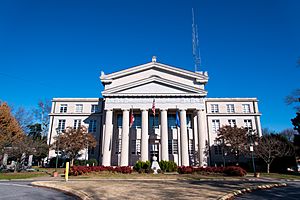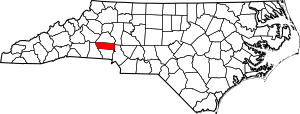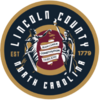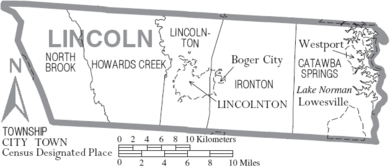Lincoln County, North Carolina facts for kids
Quick facts for kids
Lincoln County
|
|||
|---|---|---|---|

Lincoln County Courthouse
|
|||
|
|||

Location within the U.S. state of North Carolina
|
|||
 North Carolina's location within the U.S. |
|||
| Country | |||
| State | |||
| Founded | 1779 | ||
| Named for | Benjamin Lincoln | ||
| Seat | Lincolnton | ||
| Largest community | Lincolnton | ||
| Area | |||
| • Total | 304.87 sq mi (789.6 km2) | ||
| • Land | 295.85 sq mi (766.2 km2) | ||
| • Water | 9.02 sq mi (23.4 km2) 2.96% | ||
| Population
(2020)
|
|||
| • Total | 86,810 | ||
| • Estimate
(2023)
|
95,675 |
||
| • Density | 284.744/sq mi (109.940/km2) | ||
| Time zone | UTC−5 (Eastern) | ||
| • Summer (DST) | UTC−4 (EDT) | ||
| Congressional district | 10th | ||
Lincoln County is a place in North Carolina, a state in the United States. In 2020, about 86,810 people lived here. This makes it the "Lincoln County" with the most people in the whole U.S. The main town and center of the county is Lincolnton. Lincoln County is also part of the bigger Charlotte-Concord-Gastonia, NC-SC Metropolitan Statistical Area.
Contents
History of Lincoln County
Lincoln County was created in 1779. It was made from the eastern part of an older area called Tryon County. European settlers first came to this area in the mid-1700s.
The county was named after Benjamin Lincoln. He was an important general during the American Revolutionary War. During this war, a battle called the Battle of Ramsour's Mill happened near a mill in Lincolnton.
Over the years, parts of Lincoln County were used to create other counties. In 1782, some land from Burke County was added to Lincoln County. Later, in 1841, parts of Lincoln County and Rutherford County became Cleveland County. In 1842, the northern part of Lincoln County became Catawba County. Finally, in 1846, the southern half of what was left of Lincoln County became Gaston County.
Geography of Lincoln County
Lincoln County covers about 304.87 square miles. Most of this area, about 295.85 square miles, is land. The rest, about 9.02 square miles, is water.
Protected Natural Areas
Lincoln County has several special places that are protected for nature and outdoor activities.
- Mountain Island Educational State Forest (part of it is in Lincoln County)
- Pee Wee's Mountain Bike Trail
- Rock Springs Nature Preserve
- South Fork Rail Trail
Major Rivers and Creeks
Many important water bodies flow through Lincoln County.
- Anderson Creek
- Ballard Creek
- Buffalo Creek
- Catawba River
- Crooked Creek
- Howard Creek
- Hoyle Creek
- Indian Creek
- Killian Creek
- Lake Norman
- Little Indian Creek
- South Fork Catawba River
- Tanyard Creek
Neighboring Counties
Lincoln County shares borders with several other counties:
- Catawba County – to the north
- Iredell County – to the northeast
- Mecklenburg County – to the southeast
- Gaston County – to the south
- Cleveland County – to the west
- Burke County – to the northwest
Main Roads and Transportation
 US 321
US 321


 US 321 Bus.
US 321 Bus. NC 10
NC 10 NC 16
NC 16
 NC 16 Bus.
NC 16 Bus. NC 18
NC 18 NC 27
NC 27
 NC 27 Truck
NC 27 Truck NC 73
NC 73 NC 150
NC 150 NC 155
NC 155 NC 182
NC 182 NC 274
NC 274
Lincoln County also has its own airport:
- Lincoln County Airport
Population Changes Over Time
| Historical population | |||
|---|---|---|---|
| Census | Pop. | %± | |
| 1790 | 9,246 | — | |
| 1800 | 12,660 | 36.9% | |
| 1810 | 16,359 | 29.2% | |
| 1820 | 18,147 | 10.9% | |
| 1830 | 22,455 | 23.7% | |
| 1840 | 25,160 | 12.0% | |
| 1850 | 7,746 | −69.2% | |
| 1860 | 8,195 | 5.8% | |
| 1870 | 9,573 | 16.8% | |
| 1880 | 11,061 | 15.5% | |
| 1890 | 12,586 | 13.8% | |
| 1900 | 15,498 | 23.1% | |
| 1910 | 17,132 | 10.5% | |
| 1920 | 17,862 | 4.3% | |
| 1930 | 22,872 | 28.0% | |
| 1940 | 24,187 | 5.7% | |
| 1950 | 27,459 | 13.5% | |
| 1960 | 28,814 | 4.9% | |
| 1970 | 32,682 | 13.4% | |
| 1980 | 42,372 | 29.6% | |
| 1990 | 50,319 | 18.8% | |
| 2000 | 63,780 | 26.8% | |
| 2010 | 78,265 | 22.7% | |
| 2020 | 86,810 | 10.9% | |
| 2023 (est.) | 95,675 | 22.2% | |
| U.S. Decennial Census 1790–1960 1900–1990 1990–2000 2010 2020 |
|||
People in Lincoln County (2020)
In 2020, the census showed that 86,810 people lived in Lincoln County. There were 34,418 households and 24,445 families. Most people, about 82.55%, were White. About 5.07% were Black or African American, and 7.39% were Hispanic or Latino.
Education in Lincoln County
Lincoln County offers different levels of education for its residents.
Colleges and Higher Education
- Gaston College - This community college has a campus in Lincolnton. It offers programs for associate degrees, certificates, and diplomas.
Lincoln County Public Schools
High Schools
- East Lincoln High School
- Lincoln County School of Technology
- Lincolnton High School
- North Lincoln High School
- West Lincoln High School
Middle Schools
- Asbury Academy
- East Lincoln Middle School
- Lincolnton Middle School
- North Lincoln Middle School
- West Lincoln Middle School
Intermediate Schools
- Pumpkin Center Intermediate School
Elementary Schools
- Asbury Elementary School
- Battleground Elementary School
- Catawba Springs Elementary School
- G. E. Massey Elementary School
- Iron Station Elementary School
- Love Memorial Elementary School
- Norris S. Childers Elementary School
- North Brook Elementary School
- Pumpkin Center Primary School
- Rock Springs Elementary School
- S. Ray Lowder Elementary School
- St. James Elementary School
- Union Elementary School
Charter Schools
- Lincoln Charter School
Communities in Lincoln County
Cities
- Lincolnton (This is the main town and the biggest community.)
Towns
- Maiden (part of this town is in Lincoln County)
Census-Designated Places
These are areas that are like towns but are not officially incorporated as cities or towns.
- Crouse
- Denver
- Iron Station
- Lowesville
- Westport
Unincorporated Communities
These are smaller communities that are not part of any city or town.
- Flay
- Laboratory
- Laurel Hill
- Polkadot
- Reepsville
- Toluca (part)
- Vale
Townships
Townships are smaller divisions of the county, often used for local government or land records.
- Catawba Springs
- Howards Creek
- Ironton
- Lincolnton
- North Brook
See also
 In Spanish: Condado de Lincoln (Carolina del Norte) para niños
In Spanish: Condado de Lincoln (Carolina del Norte) para niños




